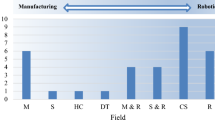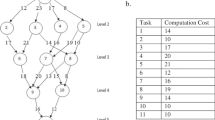Abstract
This paper describes an FMS scheduling method that treats an FMS as a group of problem-solving agents cooperating to perform manufacturing jobs. The main thrusts of such a method include the ability to handle the dynamically changing production conditions, its taking into account the communication method, the improved reliability, and the use of distributed control. The paper emphasizes research issues associated with various aspects of the cooperative problem-solving method, including: (1) dynamic task assignments, (2) the coordination mechanism, and (3) knowledge-based scheduling as problem solving. A simulation study which compares the performance of the cooperative problem solving approach with that of the more traditional scheduling approaches is also reported.
Similar content being viewed by others
References
R. Axelrod,The Evolution of Cooperation (Basic Books, Inc., New York, 1984).
K. Baker,Introduction to Sequencing and Scheduling (John Wiley & Sons, New York, 1974).
J.H. Blackston, D.T. Phillips and G.L. Hogg, A state-of-the-art survey of dispatching rules for manufacturing job shop operations, International Journal of Production Research 20, No. 1 (1982) 27.
D. Bourne and P. Fussell, Designing programming languages for manufacturing cells, Technical Report CMU-R1-Tr-82-5, The Robotics Institute, Carnegie Mellon University, 1982.
Y.L. Chang, R.S. Sullivan and U. Bagchi, Experimental investigation of quasi-realtime scheduling in flexible manufacturing,Proc. First ORSA/TIMS Conference on FMS, 1984.
R. Conway, B. Johnson and W. Maxwell, An experimental investigation of priority dispatching, J. of Ind. Enging 11 (1962) 221.
R. Conway and W. Maxwell, Network dispatching by shortest operation discipline. Operations Research 10 (1962) 51.
M. Cutkosky, P. Fussell and R. Milligan, Precision flexible machining cells within a manufacturing systems, Technical Report CMU-RI-TR-84-12, The Robotics Institute, Carnegie-Mellon University, 1984.
A. Danthine, Protocol representation with finite state models, IEEE Transactions on Communications (1980) 632–642.
R. Davis, A model for planning in a multi-agent environment: steps toward principles for teamwork, Working Paper 217, MIT AI Lab., 1981.
R. Davis and R. Smith, Negotiation as a metaphor for distributed problem solving, Artificial Intelligence 20 (1983) 63–109.
S. French,Sequencing and Scheduling: An Introduction to the Mathematics of the Job-Shop (John Wiley, New York, 1982).
M. Georgeff, Procedural control in production systems, Artificial Intelligence 18 (1982) 175–201.
T. Greene and R. Sadowski, A review of cellular manufacturing assumptions, advantages, and design techniques, Journal of Operations Management4, No. 2 (1984) pp. 85–97.
M. Harris and A. Raviv, Allocation mechanisms and the design of auction, Econometrica 49, No. 6 (1981) 1477–1499.
R. Keil and S. Dillon, Manufacturing Automation Protocol (MAP) specification, General Motors Technical Center (Warren, Michigan, 1985).
J. Kimemia and S. Gershwin, Flow optimization in flexible manufacturing systems, Int. J. Prod. Res. 23, No. 1 (1985) 81–96.
A. Maira, Local area networks A— the future of the factory, Manufacturing Engineering 96, No. 3 (1986).
T.W. Malone, R.E. Fikes and M.T. Howard, Enterprise: a market-like task schedular for distributed computing environments, Working Paper, Xerox Palo Alto Research Center, 1983.
T. Malone and S. Smith, Tradeoffs in designing organizations: implications for new forms of human organizations and computer systems, Working Paper No. 1541–84, Sloan School of Management, Massachusetts Institute of Technology, 1984.
C.R. McLean, H.M. Bloom and T.H. Hopp,The Virtual Manufacturing Cell, Information Control Problems in Manufacturing Technology (McGregor & Werner, Washington, D.C., 1982).
C. McLean, M. Mitchell and E. Barkmeyer, A computer architecture for small-batch manufacturing, IEEE Spectrum (1983) 59.
C.T. Mosier, D.A. Elvers and D. Kelly, Analysis of group technology scheduling heuristics, Internation Journal of Production Research, 22, No. 5 (1984) 857.
R. Nelson, L. Haibt and P. Sheridan, Casting Petri nets into programs, IEEE Trans. on Software Engineering, SE-9, No. 5 (1983) 590–602.
A. Newell and H. Simon,Human Problem Solving (Prentice-Hall, Englewood, New Jersey, 1972).
N. Nilsson,Principles of Artificial Intelligence (Tioga, Palo Alto, California, 1980).
M.E. Oren and A.C. Williams, On competitive bidding, Operations Research, 23 (1975) 1072–1079.
J. Peterson, Petri net and the modeling of systems (Prentice-Hall, Englewood Cliffs, New Jersey, 1981).
K. Ramamritham and J. Stankovic, Dynamic task scheduling in hard real-time distributed systems,Proc. Distributed Computing Systems, IEEE Computer Society Press, 1984.
P. Ranky,Computer Integrated Manufacturing (Prentice-Hall, Englewood, New Jersey, 1986).
J. Rosenschein and M. Genesereth, Communication and cooperation, Technical Report HPP-84-5, Computer Science Department, Stanford University, 1984.
J.D. Schoeffler, Distributed computer systems for industrial process control, Computer 17, No. 2 (1984) 11.
J.G. Shanthikumar and R.G. Sargent, A hybrid simulation analytical model of a computerized manufacturing system, Working Paper 80-017, Dept. of Industrial Engineering and Operations Research, Syracuse University, 1980.
M. Shaw, A two-level approach to scheduling in computer integrated manufacturing,Proc. NBS Symposium on Real-Time Optimization in Automated Manufacturing Facilities, National Bureau of Standards, U.S.A., 1986.
M. Shaw, A distributed scheduling scheme for computer integrated manufacturing: the use of local area network for cellular systems, BEBR Working Paper No. 1244, University of Illinois, 1986.
M. Shaw, A pattern-directed approach to FMS scheduling,Proc. 2nd ORSA/TIMS Conference on Flexible Manufacturing Systems, Ann Arbor, Michigan, 1986.
M. Shaw, Applying artificial intelligence to the scheduling of flexible manufacturing systems, a pattern-directed approach, Faculty Working Paper No. 1301, College of Commerce and Business Administration, 1986.
M. Shaw and A. Whinston, A distributed knowledge-based approach to flexible automation, Working Paper, Decision and Information Sciences, University of Illinois, 1985. A shorter version appeared inProc. IEEE Conf. on A.I. Application.
M. Shaw and A. Whinston, Automated planning and flexible scheduling,Proc. Int. Conf. on Automation and Robotics, St. Louis, MO, 1985.
M. Shaw and A. Whinston, Application of artificial intelligence to planning and scheduling in flexible manufacturing, in:Flexible Manufacturing System: Methods and Studies, ed. A. Kusiak (North-Holland, 1986).
R.K. Sikha and R.H. Hollier, A review of production control problems in cellular manufacturing, International Journal of Production Research 22, No. 5 (1984) 773.
H. Simon,The Sciences of the Artificial (The MIT Press, Cambridge, Massachusetts, 1982).
J.A. Simpson, R.J. Hocken and J.S. Albus, The automated manufacturing research facility of the National Bureau of Standards, Journal of Manufacturing 1, No. 1 (1982).
R.G. Smith, The contract net protocol: high-level communication and control in a distributed problem solver, IEEE Trans. Computers, Vol. C-29, No. 12 (1980).
J.J. Solberg, A mathematical model of computerized manufacturing systems,Proc. 4th Int. Conf. on Production Research, Tokyo, Japan, 1977.
K. Stecke and B. Schmeiser, Equivalent representation of system throughput in a closed queueing network models of multiserver queues, Working Paper No. 324, Division of Research, Graduate School of Business Administration, The University of Michigan, Ann Arbor, Michigan, 1982.
K. Stecke and J. Solberg, The optiality of unbalancing both workloads and machine group sizes in closed queueing networks of multiserver queues, Operations Research 33, 4 (1985) 882–910.
A. Tanenbaum,Computer Networks (Prentice-Hall, New Jersey, 1981).
M. Zisman, Use of production systems for modelling asynchronous concurrent processes, in:Pattern Directed Inference Systems, eds. D. Waterman and F. Hayes-Roth (Academic Press, New York, 1978).
Author information
Authors and Affiliations
Rights and permissions
About this article
Cite this article
Shaw, M.J. FMS scheduling as cooperative problem solving. Ann Oper Res 17, 323–345 (1989). https://doi.org/10.1007/BF02096612
Issue Date:
DOI: https://doi.org/10.1007/BF02096612




